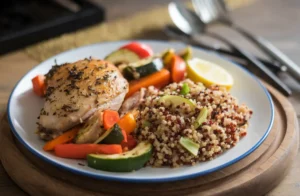When dealing with acid reflux, food choices and preparation methods play a crucial role in managing symptoms and preventing flare-ups. The Acid Reflux Diet isn’t just a meal plan but a lifestyle shift, emphasizing foods that minimize stomach acid production and reduce the chance of acid traveling up the esophagus. This blog will take you through the essentials of cooking for an acid reflux diet, discuss ingredient selections, explore cooking techniques, and share recipes that will keep both your digestive system and taste buds happy. By understanding the science behind acid reflux and incorporating thoughtful cooking practices, you can manage your condition effectively.
Understanding Acid Reflux and Its Dietary Needs
What is Acid Reflux? Acid reflux occurs when stomach acid flows back into the esophagus, leading to symptoms like heartburn, chest pain, and regurgitation. The condition is often linked to a weak lower esophageal sphincter (LES), which allows stomach contents to escape into the esophagus. If acid reflux becomes chronic, it may develop into gastroesophageal reflux disease (GERD).
How Diet Affects Acid Reflux Certain foods and beverages can trigger Acid Reflux Diet by either relaxing the LES or increasing stomach acid production. Spicy foods, fatty meals, caffeine, alcohol, and acidic fruits are common culprits. On the flip side, some foods are known to soothe the digestive tract and support a healthy LES, reducing symptoms of acid reflux. Cooking with these beneficial ingredients is key to following an acid reflux diet successfully.
Selecting Ingredients for an Acid Reflux-Friendly Diet
1. Low-Acidity Fruits and Vegetables Acidic fruits like oranges, tomatoes, and lemons are often off-limits for acid reflux sufferers. Instead, focus on low-acid fruits such as bananas, melons, apples, and pears. Vegetables, particularly green leafy ones like spinach, kale, and broccoli, are excellent choices as they are non-acidic and help balance stomach pH.
Pro Tip: When cooking with fruits or vegetables, always opt for fresh produce over canned varieties, which may contain preservatives or high amounts of sodium that could exacerbate symptoms. Steaming or roasting vegetables can also make them easier to digest.
2. Lean Proteins Fats have been shown to relax the LES, leading to increased acid reflux. Therefore, high-fat meats like beef or pork may cause discomfort. Lean protein sources such as chicken breast, turkey, and fish are better alternatives. Tofu, beans, and legumes are also excellent sources of protein, particularly for those following a plant-based diet.
Cooking Tip: Grill, bake, or poach proteins instead of frying them. Avoid adding excessive oil or butter, and use herbs and spices that do not trigger reflux, such as basil, parsley, or turmeric.
3. Whole Grains Whole grains like oatmeal, brown rice, and quinoa are staples in an acid reflux diet. They are not only rich in fiber, which aids digestion, but they also help absorb excess stomach acid, providing relief from heartburn. Refined grains like white bread or pasta may exacerbate symptoms and should be consumed sparingly.
Nutrition Insight: Whole grains provide slow-digesting complex carbohydrates that keep you feeling full for longer and help maintain stable blood sugar levels, reducing the chance of overeating, which can trigger reflux.
4. Healthy Fats While fatty foods can worsen Acid Reflux Diet , not all fats are created equal. Healthy fats, such as those found in avocados, flaxseeds, chia seeds, and olive oil, can be safely included in an acid reflux diet in moderation. These fats help to nourish the body without contributing to LES dysfunction.
Expert Advice: Incorporate healthy fats through dressings, marinades, or by adding seeds to your morning oatmeal. Avoid heavy creams or full-fat dairy products, which are more likely to trigger symptoms.
5. Dairy Alternatives Dairy products, especially those high in fat, can trigger acid reflux in some people. Switching to plant-based alternatives like almond milk, oat milk, or soy milk can be a safer option. Low-fat or fat-free versions of yogurt and cheese are also recommended over full-fat varieties.
Ingredient Substitution: When cooking, try replacing heavy cream with coconut cream or soy-based alternatives for a lighter, reflux-friendly option.
Meal Preparation Techniques for an Acid Reflux Diet
1. Steaming and Boiling Steaming and boiling are gentle cooking methods that preserve nutrients while avoiding the need for added fats. Vegetables, grains, and lean proteins can all be cooked this way without introducing reflux-triggering oils or spices.
Steaming Tip: Use a steamer basket or bamboo steamer to cook vegetables until tender but still vibrant. Season lightly with salt, or add a squeeze of lemon (if tolerated) for brightness.
2. Grilling and Baking Grilling or baking lean proteins like chicken, fish, or tofu provides flavor without excessive fat. These methods allow the natural flavors of the food to develop without the need for heavy sauces or frying oils that can aggravate acid reflux.
Grill Master Tip: Keep marinades simple and free of acidic ingredients like vinegar or citrus. Instead, use herbs like thyme, rosemary, or sage to flavor your proteins.
3. Sauteing with Caution Sauteing can be done in a reflux-friendly way if done with care. Use small amounts of healthy oils like olive oil, and cook at lower temperatures to prevent the oil from smoking, which can irritate the digestive tract.
Sautéing Technique: Avoid garlic and onions, which are common triggers. Instead, flavor dishes with ginger, which has natural anti-inflammatory properties that may help soothe the stomach.
Sample Acid Reflux Diet Recipes

Breakfast: Oatmeal with Bananas and Almond Milk
Ingredients:
- 1/2 cup rolled oats
- 1 cup almond milk
- 1 ripe banana, sliced
- 1 tablespoon flaxseeds
- 1 teaspoon cinnamon
Instructions:
- Bring almond milk to a simmer in a small saucepan.
- Stir in the oats and cook for 5-7 minutes until the mixture thickens.
- Top with banana slices, flaxseeds, and cinnamon before serving.
Why This Works: Oatmeal is high in fiber, and bananas are low in acid, making this a soothing start to your day. Almond milk adds creaminess without the heaviness of dairy.
Lunch: Grilled Chicken and Quinoa Salad
Ingredients:
- 1 boneless, skinless chicken breast
- 1 cup cooked quinoa
- 1/2 cucumber, diced
- 1/2 avocado, sliced
- Mixed greens
- 1 tablespoon olive oil
- Fresh parsley for garnish
Instructions:
- Grill the chicken breast until fully cooked, then slice.
- In a large bowl, combine quinoa, cucumber, avocado, and mixed greens.
- Drizzle with olive oil and top with sliced chicken. Garnish with parsley.
Why This Works: This salad is rich in lean protein and healthy fats while remaining light on the digestive system. The quinoa adds a boost of fiber to help absorb stomach acid.
Dinner: Baked Salmon with Steamed Vegetables
Ingredients:
- 1 fillet of salmon
- 1 tablespoon olive oil
- 1/2 teaspoon turmeric
- 1/2 teaspoon fresh dill
- Steamed broccoli and carrots for serving
Instructions:
- Preheat the oven to 375°F (190°C). Place the salmon fillet on a baking sheet lined with parchment paper.
- Drizzle with olive oil and sprinkle with turmeric and dill.
- Bake for 15-20 minutes until the fish flakes easily with a fork.
- Serve alongside steamed broccoli and carrots.
Why This Works: Salmon is rich in omega-3 fatty acids, which are beneficial for reducing inflammation. Turmeric is a natural anti-inflammatory, and steamed vegetables provide essential vitamins and minerals.
Snack: Apple Slices with Almond Butter
Ingredients:
- 1 apple, sliced
- 2 tablespoons almond butter
Instructions:
- Slice the apple and serve with a side of almond butter for dipping.
Why This Works: Apples are low in acid, and almond butter provides a healthy fat source without irritating the LES.
Frequently Asked Questions
1. Can I use spices on an acid reflux diet ? Yes, but with caution. Certain spices like chili powder, black pepper, and garlic can exacerbate symptoms of acid reflux. Instead, focus on herbs and spices that are known to soothe the digestive system, such as ginger, turmeric, parsley, and basil. Fresh herbs are particularly beneficial and can add flavor without causing heartburn.
2. Is dairy bad for acid reflux diet ? For some individuals, full-fat dairy can worsen acid reflux symptoms due to the high-fat content, which can relax the LES. Switching to low-fat or plant-based alternatives like almond milk, oat milk, or soy milk may help reduce symptoms. It’s important to note that not everyone with acid reflux is sensitive to dairy, so it can vary from person to person.
3. Are acidic fruits off-limits? Generally, acidic fruits such as oranges, grapefruits, and lemons can trigger acid reflux symptoms and should be avoided. However, low-acid fruits like bananas, melons, and apples are typically safe for consumption. It’s advisable to test your tolerance gradually.
4. What is the best beverage to drink on an acid reflux diet? Water is the best option for staying hydrated without irritating your stomach. Herbal teas, such as ginger or chamomile, can also be soothing for the digestive system. Avoid caffeinated drinks, carbonated beverages, and alcohol, as they can all trigger acid reflux symptoms.
5. Can I eat grains if I have Acid Reflux Diet ? Yes, whole grains like brown rice, oatmeal, and quinoa are excellent choices for managing acid reflux. They provide fiber, which aids digestion and helps absorb excess stomach acid. Refined grains should be limited, as they may not offer the same benefits.
Pairing Suggestions for an Acid Reflux Diet

While managing acid reflux, it’s important to consider not only what you eat but how you pair your meals. Eating the right combinations of foods can help further reduce the risk of symptoms.
- Proteins with Non-Starchy Vegetables: Pair lean meats like chicken or turkey with leafy greens or steamed vegetables. The fiber in the vegetables helps regulate digestion, while the lean proteins provide necessary nutrients without overwhelming your digestive system.
- Fruits with Whole Grains: Low-acid fruits paired with whole grains create a balanced snack or meal that is both satisfying and gentle on the stomach. For example, sliced apples with oatmeal can be a wholesome breakfast or snack.

